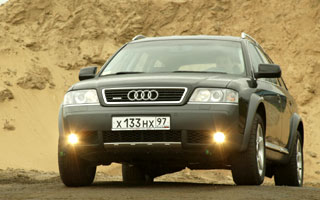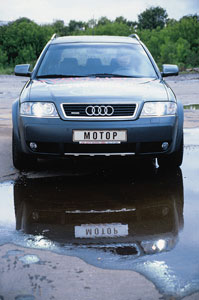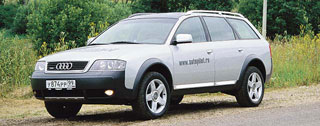Audi Allroad 2000 test drive - 2006 SUV
Audi Allroad 4.2 Quattro/ 2100 km
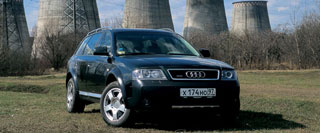 A month ago, the editorial park for six months was replenished with the most powerful and expensive modification of the Audi Allroad - 4.2 Quattro.
A month ago, the editorial park for six months was replenished with the most powerful and expensive modification of the Audi Allroad - 4.2 Quattro. All and Off. Exactly four years ago, the public was presented with the first Allroad with 2.5 TDI engines and 2.7 Biturbo, but the debut of the model with atmospheric eight ambitious audimas had to wait two years. For about a year, the car was stuck somewhere between Ingolstadt and Moscow-4.2 full-fledged sales began only last year.
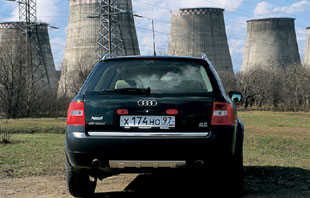 The Allroad all -resistant model inherited from its ancestor, the A6 Avant station wagon, a body, an all -wheel drive transmission with the TORSEN center differential, the aluminum elements of the body and much more, but at the same time received a completely new air suspension. It was thanks to her that Allroad for four years of release earned the glory of a much more serious all -terrain vehicle than classmates Subaru and Volvo. An eternal dispute with another Bavarian automaker is a separate topic: during a long -term test, we will definitely try to reduce AlloD with BMW X5.
The Allroad all -resistant model inherited from its ancestor, the A6 Avant station wagon, a body, an all -wheel drive transmission with the TORSEN center differential, the aluminum elements of the body and much more, but at the same time received a completely new air suspension. It was thanks to her that Allroad for four years of release earned the glory of a much more serious all -terrain vehicle than classmates Subaru and Volvo. An eternal dispute with another Bavarian automaker is a separate topic: during a long -term test, we will definitely try to reduce AlloD with BMW X5. Eight in the mind. Until recently, the 2.7 Biturbo motor was the most powerful in the ALLROD line: 250 horses and two high -pressure turbines shot this barn up to a hundred 7.7 s. Even the AlloD tuning business arose: some craftsmen managed to shoot from the motor and 270 and 350 horses. However, no one managed to get rid of one generic feature of AlloD 2.7: the motor inevitably fell into the notorious turboyam. Here, as they say, nothing can be done.
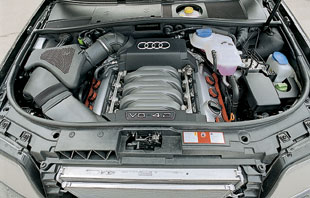 The roar of two massive pipes of the exhaust system is the first thing that distinguishes Allroad 4.2 from its predecessors. We think this was done intentionally: after all, only a new nameplate and these pipes are visually distinguished. A motor similar in volume to what is installed on the new A8 limousine is a separate story. Ask any Audi seller, is it the very engine that the new eight has? They will not answer you. There will be no deception in this, but a certain share of cunning is still present. The thing is that marketer to a large extent dictates the task of designers today. In this case, it sounds conditionally like this: you can not make the same motors for the flagship limousine and a wagon lower in status. But in practice it turned out the following: A8 with a 4.2 liter engine by 35 hp. It is more powerful and 0.9 C faster in the acceleration of Ollroad. Who was strangled or who was inflated is the secret of the company. However, one should not forget that the flagship costs almost $ 30 thousand more.
The roar of two massive pipes of the exhaust system is the first thing that distinguishes Allroad 4.2 from its predecessors. We think this was done intentionally: after all, only a new nameplate and these pipes are visually distinguished. A motor similar in volume to what is installed on the new A8 limousine is a separate story. Ask any Audi seller, is it the very engine that the new eight has? They will not answer you. There will be no deception in this, but a certain share of cunning is still present. The thing is that marketer to a large extent dictates the task of designers today. In this case, it sounds conditionally like this: you can not make the same motors for the flagship limousine and a wagon lower in status. But in practice it turned out the following: A8 with a 4.2 liter engine by 35 hp. It is more powerful and 0.9 C faster in the acceleration of Ollroad. Who was strangled or who was inflated is the secret of the company. However, one should not forget that the flagship costs almost $ 30 thousand more. 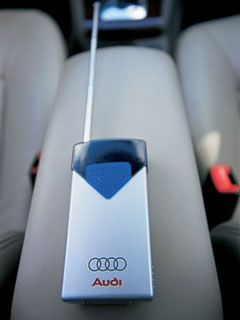 Color and plot. Our car is painted in a very stylish green. This is the same color that changes depending on illumination. That is, on a bright sunny day, emerald is visible in it, and in the evening or in the rain the car becomes almost black.
Color and plot. Our car is painted in a very stylish green. This is the same color that changes depending on illumination. That is, on a bright sunny day, emerald is visible in it, and in the evening or in the rain the car becomes almost black. The base of the AlloD design is a carrying body of galvanized steel, some elements of which (for example, hood) are made of aluminum alloy. Like all QUATTRO models, the station wagon is equipped with a mechanical Torsen interdosseous differential with an electronic EDL locking system. The differential can transmit two -thirds of the engine power to any bridge depending on the road conditions.
That is, the car becomes the front, then rear-wheel drive. The elastic elements of an independent suspension installed on hard subframes are special cylinders filled with air. It is they that allow you to change the road clearance in the range from 14 to 21 cm. At the same time, the computer retains the selected value regardless of the load and weight of the car, and the size of the suspension of each wheel is monitored by a special sensor. An uneven load, for example, when there is a load in the trunk, is compensated by different pressure in pneumo elements. Four suspension provisions are possible. The lowest (minimum road clearance of 142 mm) is used at speeds over 120 km/h. In this position is low
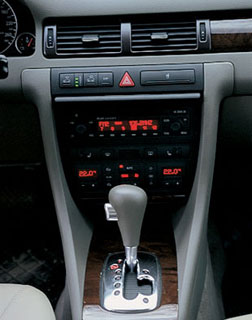 the center of gravity significantly increases stability, and aerodynamic characteristics improve. The second stage (167 mm) is used at speeds from 80 to 120 km/h, and it, in general, is also designed for good roads. The third version of the road clearance - 192 mm - is used when driving along roads that do not have a stable coating. It is maintained by a computer at speeds up to 80 km/h, and is also automatically installed when stopping for the convenience of landing and eating. That is, if the Range Rover or Lexus, for example, is squatted in the parking lot, then AlloD, on the contrary, lifts up. Interestingly, the largest road clearance of 21 cm is quite comparable to the clearance of Jeep Grand Cherokee or Toyota Rav4. This position is designed for very cruel (in European, naturally, understanding) conditions of movement. The clearance can be adjusted by hand with two buttons on the dashboard. The decrease occurs immediately, and the increase is after a while. The smart computer will not allow the driver to choose a dangerous high position of the body, and after excess speed 80 and 120 km/h, for 30 s, will reduce the clearance to a safe value.
the center of gravity significantly increases stability, and aerodynamic characteristics improve. The second stage (167 mm) is used at speeds from 80 to 120 km/h, and it, in general, is also designed for good roads. The third version of the road clearance - 192 mm - is used when driving along roads that do not have a stable coating. It is maintained by a computer at speeds up to 80 km/h, and is also automatically installed when stopping for the convenience of landing and eating. That is, if the Range Rover or Lexus, for example, is squatted in the parking lot, then AlloD, on the contrary, lifts up. Interestingly, the largest road clearance of 21 cm is quite comparable to the clearance of Jeep Grand Cherokee or Toyota Rav4. This position is designed for very cruel (in European, naturally, understanding) conditions of movement. The clearance can be adjusted by hand with two buttons on the dashboard. The decrease occurs immediately, and the increase is after a while. The smart computer will not allow the driver to choose a dangerous high position of the body, and after excess speed 80 and 120 km/h, for 30 s, will reduce the clearance to a safe value. +/- We are used to the fact that a new car needs about a thousand and a half kilometers to roll. Therefore, all this period was spared the car and they did not ask particularly strictly from it. We were reciprocated: the fuel consumption, which at first, went off scale for 22 l/100 km, stabilized at the level of 18.5 liters. One thing is bad: with a tank capacity of about 70 liters, if you dangle around the city all day, you need to go to the gas station after a day.
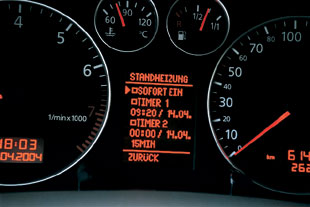 -/+ a strange, even amazing story happened with the wheels. We got the car on very good rubber Pirelli P6 Allroad and relatives of 17-inch cast discs, the design of which would be envied even by tuning experts. For a week we traveled on this quite summer rubber along the snow melting before our eyes without any problems. Literally after 500 km of run, a weak beating began, which, intensified, began to be transferred at high speeds into the steering wheel. We hastened to balancing. Electronics stubbornly kept repeating to us that the wheels were admitted to zero, that is, everything is in order. The steering wheel still beat. The sellers of the tires called. After a short consultation, we were advised not to rape the car, travel another day or two, and if it does not help, go to a rather rare procedure for finish balancing. After 200 km - Oh miracle! - Everything has passed. We tortured sellers: What's the matter? Well, the rubber got used to the car, it happens, they answered us.
-/+ a strange, even amazing story happened with the wheels. We got the car on very good rubber Pirelli P6 Allroad and relatives of 17-inch cast discs, the design of which would be envied even by tuning experts. For a week we traveled on this quite summer rubber along the snow melting before our eyes without any problems. Literally after 500 km of run, a weak beating began, which, intensified, began to be transferred at high speeds into the steering wheel. We hastened to balancing. Electronics stubbornly kept repeating to us that the wheels were admitted to zero, that is, everything is in order. The steering wheel still beat. The sellers of the tires called. After a short consultation, we were advised not to rape the car, travel another day or two, and if it does not help, go to a rather rare procedure for finish balancing. After 200 km - Oh miracle! - Everything has passed. We tortured sellers: What's the matter? Well, the rubber got used to the car, it happens, they answered us. + In changeable April days and nights, we appreciated the pre -launch not only a warm steering wheel, but also the Webasto heater, which is being completed by the car. The cost of this feature is considerable - almost $ 2300, but the pleasure of instant start on a warm machine costs this money. The heater can be turned on both remotely, using a radio remote control and programmed for a certain time: say, half an hour before you go to work in the morning. At the same time, you can not be afraid of an unpleasant surprise, which the heating systems installed on the machine sometimes present to their owners as an upgrade. This is when a frosty morning instead of cozy heat, the owner receives a completely hung battery in a frozen machine - the device feeds part of its energy. In the Audi, the battery manager simply will not allow the tolerance if he considers that the residue of the charge is not enough for a confident start.
Text Fedor Aleksandrov, photo Tatyana Salyutova
Gasoline engine V8
Working volume (cubic cub) 4163
Power (L.S. at about/min) 300 at 6200
Moment (nm at rpm) 380 at 2700
Gearbox 5-speed automatic sectral type
Length/width/height (mm) 4810/1850/1590
Wheel base (mm) 2760
Mass weight (kg) 1860
Maximum speed (km/h) 240
Acceleration to 100 km/h (c) 7.2
Price in standard configuration $ 79 885
Source: "Autopilot"






